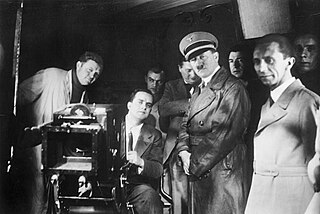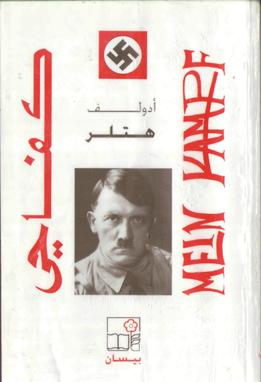
Mein Kampf is a 1925 autobiographical manifesto by Nazi Party leader Adolf Hitler. The work describes the process by which Hitler became antisemitic and outlines his political ideology and future plans for Germany. Volume 1 of Mein Kampf was published in 1925 and Volume 2 in 1926. The book was edited first by Emil Maurice, then by Hitler's deputy Rudolf Hess.

Lebensraum is a German concept of settler colonialism, the philosophy and policies of which were common to German politics from the 1890s to the 1940s. First popularized around 1901, Lebensraum became a geopolitical goal of Imperial Germany in World War I (1914–1918), as the core element of the Septemberprogramm of territorial expansion. The most extreme form of this ideology was supported by the Nazi Party and Nazi Germany. Lebensraum was a leading motivation of Nazi Germany to initiate World War II, and it would continue this policy until the end of World War II.
War Plan Orange is a series of United States Joint Army and Navy Board war plans for dealing with a possible war with Japan during the years between the First and Second World Wars. It failed to foresee the significance of the technological changes to naval warfare, including the submarine, air support and aircraft carriers, and although the Battle of Midway was important, and the US Navy did "island-hop" to regain lost territory, there was no culminating "showdown" battle as anticipated by Plan Orange.
The Tanaka Memorial is an alleged Japanese strategic planning document from 1927 in which Prime Minister Baron Tanaka Giichi laid out for Emperor Hirohito a strategy to take over the world. The authenticity of the document was long accepted and it is still quoted in some Chinese textbooks, but historian John Dower states that "most scholars now agree that it was a masterful anti-Japanese hoax."

Victory Through Air Power is a 1942 non-fiction book by Alexander P. de Seversky. It was made into a 1943 Walt Disney animated feature film of the same name.

The propaganda used by the German Nazi Party in the years leading up to and during Adolf Hitler's dictatorship of Germany from 1933 to 1945 was a crucial instrument for acquiring and maintaining power, and for the implementation of Nazi policies.

The Zweites Buch, published in English as Hitler's Secret Book and later as Hitler's Second Book, is an unedited transcript of Adolf Hitler's thoughts on foreign policy written in 1928; it was written after Mein Kampf and was not published in his lifetime.

Nazism created an elaborate system of propaganda, which made use of the new technologies of the 20th century, including cinema. Nazism courted the masses by the means of slogans that were aimed directly at the instincts and emotions of the people. The Nazis valued film as a propaganda instrument of enormous power. The interest that Adolf Hitler and his propaganda minister Joseph Goebbels took in film was not only the result of a personal fascination. The use of film for propaganda had been planned by the Nazi Party as early as 1930, when the party first established a film department. The goals of the department included using the economic power of German moviegoers to self-censor films globally, resulting in all but one Hollywood producers censoring films critical of Nazism and even showing news shorts of film produced by the Nazis in American theaters. No American films between 1933-1939 were critical of Nazism.
Kinoaki Matsuo was a Foreign Affairs Officer and Navy Admiralty Liaison, Black Dragon Society member, writer, and Japanese Navy strategizer.

Gerhard Ludwig Weinberg is a German-born American diplomatic and military historian noted for his studies in the history of Nazi Germany and World War II. Weinberg is the William Rand Kenan, Jr. Professor Emeritus of History at the University of North Carolina at Chapel Hill. He has been a member of the history faculty at UNC-Chapel Hill since 1974. Previously he served on the faculties of the University of Michigan (1959–1974) and the University of Kentucky (1957–1959).

The Russian Fascist Party (RFP), sometimes called the All-Russian Fascist Party, was a minor Russian émigré movement that was based in Manchukuo during the 1930s and 1940s.
James Vincent Murphy was an Irish translator, writer, lecturer and journalist, who published one of the first complete English translations of Mein Kampf in 1939.
The foreign policy and war aims of the Nazis have been the subject of debate among historians. The Nazis governed Germany between 1933 and 1945. There has been disagreement over whether Adolf Hitler aimed solely at European expansion and domination, or whether he planned for a long-term global empire.

Ralph Townsend was an American writer, consul and political activist noted for his opposition to the entry of the United States into World War II. He served in the foreign service as a consul stationed in Canada and China from 1931 to 1933. Shortly after returning to the United States he came to prominence through his book Ways That Are Dark: The Truth About China, a harsh critique of Chinese culture which became a widely controversial bestseller. Townsend became a prominent advocate of non-interventionism, and in the 1930s and 1940s was well known for his vocal opposition to the Roosevelt administration's foreign policy from a pro-Japanese and pro-neutrality point of view.

Mein Kampf, Adolf Hitler's 900-page autobiography outlining his political views, has been translated into Arabic a number of times since the early 1930s.
World War II changed the possibilities for animation. Prior to the war, animation was mostly seen as a form of family entertainment. The attack on Pearl Harbor was a turning point in its utility. On December 8, 1941, the United States Army began working with Walt Disney at his studio, stationing Military personnel there for the duration of the war. The Army and Disney set about making various types of films for several different audiences. Most films meant for the public included some type of propaganda, while films for the troops included training and education about a given topic.

Why Britain is at War is a polemic treatise written by Harold Nicolson and first published by Penguin Books on 7 November 1939 shortly after the Second World War began. In the book, Nicolson explores Adolf Hitler's insatiable grasp for power, the foreign policy brinkmanship and deception ploys adopted by Nazi Germany, and Hitler's use of actual and implied force to get his way at the negotiation table. The Penguin Special edition originally cost 6d and sold a hundred thousand copies.
Since the early 1930s, the history of Adolf Hitler's Mein Kampf in English has been complicated and has been the occasion for controversy. Four full translations were completed before 1945, as well as a number of extracts in newspapers, pamphlets, government documents and unpublished typescripts. Not all of these had official approval from Hitler's publishers, Eher Verlag. Since the war, the 1943 Ralph Manheim translation has been the most commonly published translation, though Manheim later expressed reservations about his translation, and other versions have continued to circulate.
Kilsoo Kenneth Haan was a Korean Nationalist, intelligence operative, anti-Japanese agitator, and both the source and translator of Kinoaki Matsuo’s contested and controversial book, The Three-Power Alliance and a United States-Japanese War.











